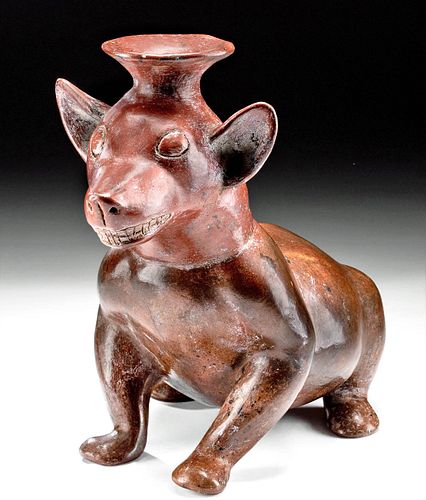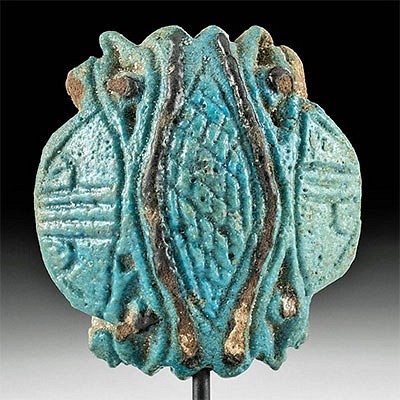Pre-Columbian Colima Redware Dog Effigy
Lot 233
About Seller
Artemis Gallery
686 S Taylor Ave, Ste 106
Louisville, CO 80027
United States
Selling antiquities, ancient and ethnographic art online since 1993, Artemis Gallery specializes in Classical Antiquities (Egyptian, Greek, Roman, Near Eastern), Asian, Pre-Columbian, African / Tribal / Oceanographic art. Our extensive inventory includes pottery, stone, metal, wood, glass and textil...Read more
Estimate:
$5,000 - $7,500
Absentee vs Live bid
Two ways to bid:
- Leave a max absentee bid and the platform will bid on your behalf up to your maximum bid during the live auction.
- Bid live during the auction and your bids will be submitted real-time to the auctioneer.
Bid Increments
| Price | Bid Increment |
|---|---|
| $0 | $25 |
| $300 | $50 |
| $1,000 | $100 |
| $2,000 | $250 |
| $5,000 | $500 |
| $10,000 | $1,000 |
| $20,000 | $2,500 |
| $50,000 | $5,000 |
| $100,000 | $10,000 |
| $200,000 | $20,000 |
About Auction
By Artemis Gallery
May 27, 2021
Set Reminder
2021-05-27 10:00:00
2021-05-27 10:00:00
America/New_York
Bidsquare
Bidsquare : CLEARANCE | Antiquities & Ethnographic Art
https://www.bidsquare.com/auctions/artemis-gallery/clearance-antiquities-ethnographic-art-7010
Featuring discounted pricing and many new items! Asian art, Classical antiquities from Egypt, Greece, Italy, and the Near East...plus Pre-Columbian, Tribal, Russian Icons & Enamelware, Spanish Colonial, Fine Art, more! Some starting prices have been reduced up to 65% from original auction prices! Artemis Gallery info@artemisgallery.com
Featuring discounted pricing and many new items! Asian art, Classical antiquities from Egypt, Greece, Italy, and the Near East...plus Pre-Columbian, Tribal, Russian Icons & Enamelware, Spanish Colonial, Fine Art, more! Some starting prices have been reduced up to 65% from original auction prices! Artemis Gallery info@artemisgallery.com
- Lot Description
**Originally Listed At $2500**
Pre-Columbian, West Mexico, Colima, ca. 300 BCE to 300 CE. A large, hand-built pottery dog vessel that is highly burnished and covered in deep red slip. Standing, but almost squatting on four short legs, the rounded body is plump, with a short-curled tail and a head jutting forward with the flared spout positioned between the perked ears. The face has an expression of fierce alertness, with incised lines forming the wide eyes, nose, and the exposed teeth, bared in a snarl. Colima vessels such as this one, were buried in shaft tombs to protect the deceased and provide sustenance for eternity. This vessel is practically the size of a life-sized pup! A fierce companion for the afterlife, with vibrant surface hues and beautiful details. Size: 16.25" L x 7.875" W x 12.31" H (41.3 cm x 20 cm x 31.3 cm)
Scholars know of at least two types of Colima dogs, one to be fattened up and ritually sacrificed or eaten, and one to serve as a watchdog and healer of the ill. This plump hairless canine, known as a Chichi or Escuintla, is thought to be related to the Chihuahua or the Mexican Hairless also known as the Xoloitzcuintle. The Xoloitzcuintle was named for the deity Xolotl, the God of the Underworld, and was believed to guide the deceased as they journeyed to the afterlife. This vessel could certainly hold a great number of offerings, and the size of the dog is impressive for an effigy figure, and certainly one can imagine how it would have discouraged any evil spirits from interfering with the deceased.
Provenance: private Arcadia, California, USA collection, acquired prior to 2000
All items legal to buy/sell under U.S. Statute covering cultural patrimony Code 2600, CHAPTER 14, and are guaranteed to be as described or your money back.
A Certificate of Authenticity will accompany all winning bids.
We ship worldwide and handle all shipping in-house for your convenience.
#159547Professionally repaired from approximately 15 pieces, with restoration over the break lines. Restoration to right front paw on the bottom and to the edge. Dime-sized area of restoration to the stomach. Surface wear and minor abrasions as expected with age. Nice mineral deposits as well as burnishing and root marks!Condition
- Shipping Info
-
All shipping is handled in-house for your convenience. Your invoice from Artemis Gallery will include shipping calculation instructions. If in doubt, please inquire BEFORE bidding for estimated shipping costs for individual items.
-
- Buyer's Premium



 EUR
EUR CAD
CAD AUD
AUD GBP
GBP MXN
MXN HKD
HKD CNY
CNY MYR
MYR SEK
SEK SGD
SGD CHF
CHF THB
THB
















